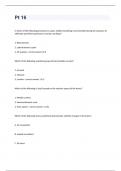Samenvatting
Summary Decision Making: Theory and Practice 2020
- Instelling
- Universiteit Leiden (UL)
- Boek
- Straight Choices
This is a summary of all materials for the 2020 Decision Making: Theory and Practice exam. It is in English and it has been written in a complete but comprehensive style. It only includes the chapters necessary for the 2020 ‘Decision Making in Practice’ exam, from the book 'Straight Choices' by...
[Meer zien]














